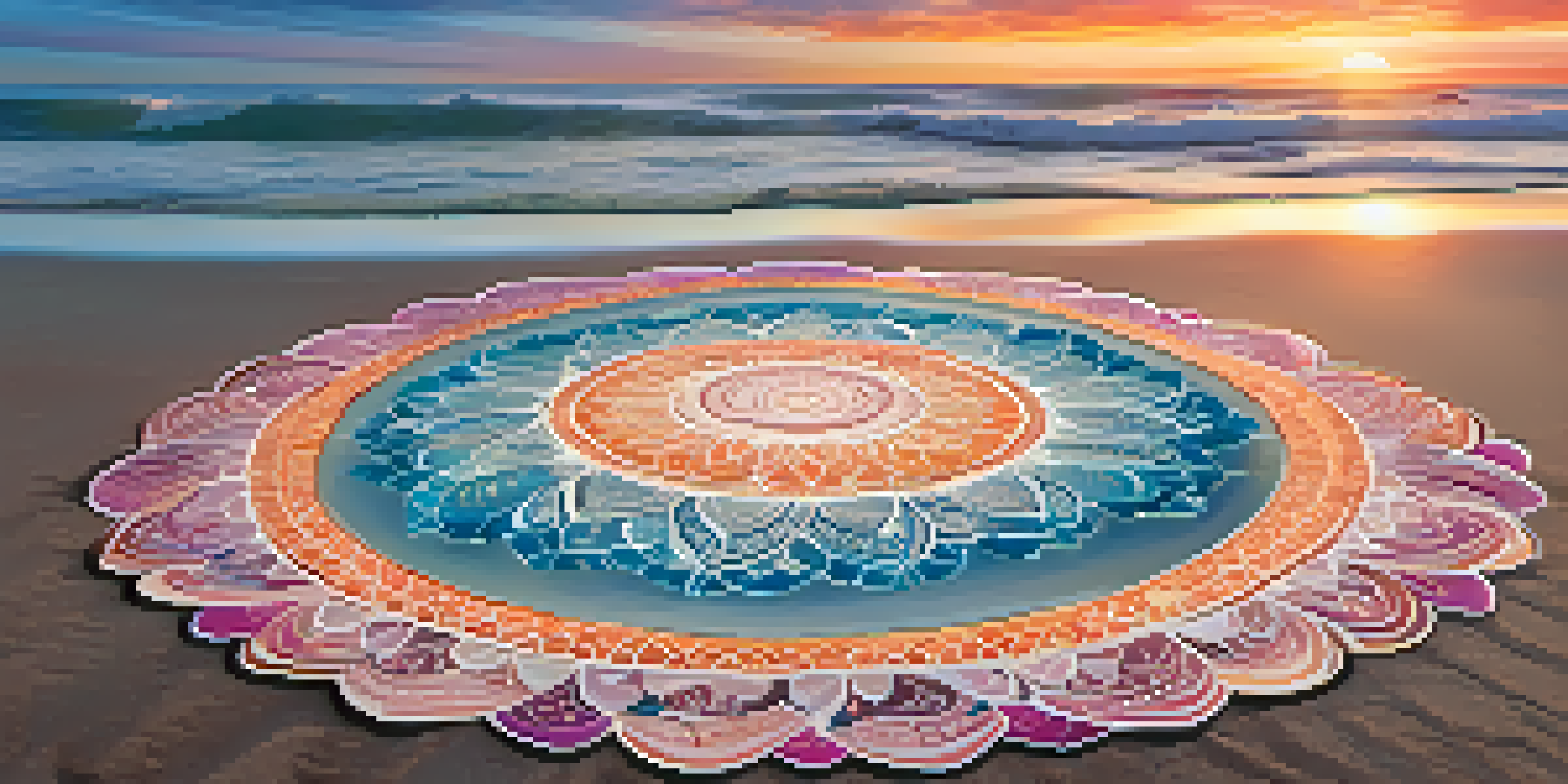The Circle as a Symbol: Its Spiritual Significance Explained

Understanding the Circle: A Universal Shape
The circle is one of the most recognizable shapes in our world, often associated with unity and wholeness. Its continuous line has no beginning or end, which symbolizes infinity and the cyclical nature of life. From ancient civilizations to modern spirituality, circles have held profound meanings that transcend cultural boundaries.
Life is a circle. The end of one journey is the beginning of another.
In many traditions, the circle represents the concept of the eternal cycle of life, death, and rebirth. For instance, in Native American cultures, the circle symbolizes the interconnectedness of all living things, emphasizing that every entity plays a crucial role in the greater whole. This perspective invites us to reflect on our place within the universe and our relationships with others.
Furthermore, the shape of the circle is often used in rituals and sacred spaces, like mandalas, which serve as tools for meditation and spiritual growth. By understanding the circle’s significance, we can appreciate its role in guiding our spiritual journeys and fostering a sense of belonging.
The Circle in Spiritual Practices and Rituals
Circles are frequently employed in spiritual practices and rituals, symbolizing harmony and balance. For example, many ancient cultures would perform rituals within a circle to create a sacred space, believing it to be a protective boundary that separates the physical world from the spiritual. This practice highlights how the circle serves as a bridge between realms.

In contemporary spirituality, circles are often used in group meditations or ceremonies, promoting a sense of community and shared intention. When people gather in a circle, it fosters equality and connection, allowing everyone to participate fully without hierarchy. This collective energy can amplify the spiritual experience, making it more potent and transformative.
Circle Symbolizes Unity and Wholeness
The circle represents interconnectedness and the eternal cycle of life, reflecting a sense of community across various cultures.
Moreover, the act of forming a circle can be a powerful reminder of our interconnectedness. It encourages us to support one another and recognize that we are all part of a larger tapestry of existence, where each thread, or individual, contributes to the overall beauty of life.
Cultural Interpretations of the Circle Symbol
Across various cultures, the circle takes on unique interpretations that reflect their values and beliefs. In Hinduism, the circle represents the cycle of samsara, the continuous cycle of birth, death, and rebirth. This understanding emphasizes the importance of living a righteous life to achieve moksha, or liberation from this cycle.
The circle is the symbol of unity, wholeness, and infinity.
Similarly, in Celtic traditions, circles are often associated with the concept of eternity and the cyclical nature of the seasons. The ancient Celts used circular stone structures for rituals, believing these sites connected them to their ancestors and the earth, reinforcing the idea that time is a continuous loop rather than a linear path.
These cultural interpretations show how the circle is not just a shape but a profound symbol that carries deep spiritual significance. By exploring these diverse meanings, we can gain a richer understanding of how different societies perceive life and the cosmos.
The Circle in Art and Architecture
The circle's influence extends beyond spiritual practices into art and architecture, where it is often used to convey harmony and beauty. Iconic structures like the Pantheon in Rome feature circular designs that create a sense of balance and unity. This architectural choice not only enhances aesthetic appeal but also reflects deeper spiritual ideals.
In art, circles are often employed to evoke feelings of completeness and eternity. Artists like Wassily Kandinsky utilized circles in their works to represent spiritual truths and the interconnectedness of all things. Through color and form, these artists invite viewers to engage with the deeper layers of existence, prompting contemplation and introspection.
Circles Enhance Spiritual Practices
In rituals and ceremonies, circles create sacred spaces that foster equality, connection, and collective energy among participants.
Furthermore, circular motifs are prevalent in mandalas and other spiritual art forms, serving as visual representations of the universe. Creating or observing these circular designs can be a meditative practice, encouraging individuals to reflect on their spiritual path and the interconnected nature of life.
The Circle and Personal Growth
On a personal level, the circle can symbolize the journey of self-discovery and growth. Just as a circle has no beginning or end, our personal development is an ongoing process filled with cycles of learning and transformation. Embracing this concept can help us approach challenges with resilience and openness.
Additionally, the circle can represent the idea of wholeness and self-acceptance. By recognizing that we are all part of a larger cycle, we can cultivate a deeper appreciation for ourselves and our experiences. This understanding promotes self-love and encourages us to embrace our unique journeys.
Incorporating the symbolism of the circle into our lives can also inspire us to build supportive communities. When we gather in circles, whether physically or metaphorically, we create spaces for sharing, healing, and growth, reinforcing the idea that we are never alone on our paths.
The Circle in Nature: A Spiritual Connection
Nature is filled with examples of circles, from the sun and moon to the rings of trees and cycles of seasons. These natural circles remind us of the interconnectedness of all living things and the beauty of life’s rhythms. Observing these patterns can deepen our appreciation for nature and our place within it.
In many spiritual traditions, nature is seen as a manifestation of the divine, and the circle serves as a reminder of this sacred connection. For instance, the changing seasons illustrate the cycle of life, death, and rebirth, reinforcing the idea that everything is part of a larger cycle. This perspective encourages us to honor and respect the natural world.
Nature Reflects the Circle's Cycle
Natural circles, like the sun and seasons, illustrate life's rhythms and deepen our appreciation for the interconnectedness of all living things.
By spending time in nature and reflecting on these circular patterns, we can foster a deeper spiritual connection. Engaging with nature can also serve as a form of meditation, allowing us to ground ourselves and find peace amidst life's chaos.
Celebrating the Circle: Festivals and Traditions
Many cultures celebrate the circle through festivals and traditions that highlight its spiritual significance. For example, the Wheel of the Year in pagan traditions represents the changing seasons and the cyclical nature of life. Celebrations such as solstices and equinoxes honor these natural cycles, fostering a sense of community and connection.
In addition to seasonal celebrations, various spiritual practices incorporate circles into their rituals. For instance, the practice of circle dancing brings people together in a joyful expression of unity and connection. These communal activities reinforce the idea of togetherness and the importance of shared experiences.

By participating in these celebrations, individuals can connect with their heritage and embrace the deeper meanings behind the circle symbol. Engaging in such traditions can also inspire a greater understanding of our shared humanity, reminding us that we are all part of the same circle of life.